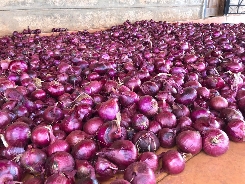Onions are one of the most widely grown and consumed vegetables around the world. They are essential in almost every kitchen and serve as a reliable source of income for farmers. Whether you’re growing onions for home use or commercial production, understanding the right practices is key to achieving high yields and quality bulbs.
The first step in onion farming is variety selection. There are different types of onions—red, white, and yellow—each suited to specific climates and markets. Choose a variety that matches your local weather conditions and consumer preference. Red onions are popular in many African markets for their strong flavor and storage quality.
Soil preparation is vital. Onions grow best in loose, well-drained, and fertile soils with a pH between 6.0 and 7.0. Heavy clay soils should be avoided as they hinder bulb formation. Deep plowing followed by fine harrowing ensures proper aeration and root development. Adding compost or well-decomposed manure improves soil fertility and structure.
Onions can be grown from seeds, seedlings, or small bulbs (sets). If starting from seed, sow them in a nursery bed about 8–10 weeks before transplanting. The nursery should be raised to prevent waterlogging and shaded to protect young plants. Once seedlings reach about 15–20 cm in height, they are ready for transplanting into the main field.
Transplanting should be done in well-prepared beds with rows spaced 25–30 cm apart and plants 10–15 cm apart within rows. Water the field before and after transplanting to reduce shock and encourage root establishment.
Irrigation is crucial throughout the growing period. Onions require consistent moisture, especially during bulb formation, but overwatering can cause diseases and reduce bulb quality. Drip irrigation or furrow systems are ideal for maintaining the right balance.
Weed management is another key step. Onions have shallow roots and compete poorly with weeds, so regular weeding is important. Mulching helps suppress weeds and maintain soil moisture.
Fertilization should be balanced and based on soil tests. Onions require nitrogen for leaf growth, phosphorus for root development, and potassium for bulb size and firmness. Organic matter or compost enhances soil health and supports sustainable production.
Onions are susceptible to pests and diseases such as thrips, onion maggots, downy mildew, and purple blotch. Regular field scouting helps in early detection. Crop rotation, use of resistant varieties, and maintaining field hygiene are effective preventive measures. If necessary, use recommended biopesticides or safe chemical options responsibly.
Onions are ready for harvest when the leaves begin to yellow and fall over naturally. Carefully lift the bulbs from the soil to avoid damage, then cure them by drying under shade for about two weeks. Proper curing improves flavor, reduces moisture, and enhances storage life.
After curing, remove the dry leaves and roots, sort the bulbs by size and quality, and store them in a cool, dry, and well-ventilated area. Proper storage prevents rotting and sprouting, allowing farmers to sell later when market prices are higher.
Beyond fresh sales, value addition such as onion powder, flakes, or pickles can increase profits and reduce post-harvest losses.
In conclusion, onion farming can be a profitable and sustainable venture when done with proper planning and good agricultural practices. From soil preparation to harvesting and marketing, every step matters. With dedication, knowledge, and consistency, farmers can produce high-quality onions that meet both local and export market standards.


